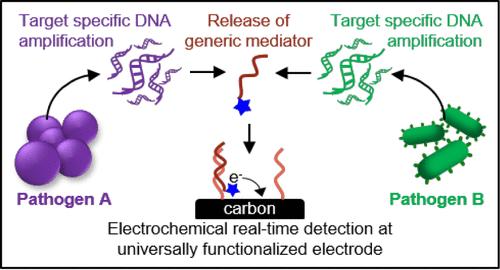基于碳电极的通用固相探针的病原体特异性电化学实时LAMP检测
IF 9.1
1区 化学
Q1 CHEMISTRY, ANALYTICAL
引用次数: 0
摘要
流行病感染和抗生素耐药性的蔓延需要能够迅速采用的诊断测试。为了减少通常耗时的分子诊断测试适应不断变化的目标,我们提出了一种可重复使用的传感电极功能化的新方法,该方法具有通用的、与靶标无关的寡核苷酸探针。在覆盖电极的液相中,目标序列通过MD LAMP(介质位移环介导的等温扩增)扩增,释放出一种通用的亚甲基蓝标记的介质,该介质与固相探针特异性杂交。为了证明该方法的普遍性,使用相同的固相探针检测了两种不同的病原体,金黄色葡萄球菌(粗裂解物)和梅毒螺旋体。反应在30 min内分别达到1 × 103和4 × 102拷贝/反应的检出限。固相探针携带羧基甲基苯胺修饰,在低成本碳电极上形成共价C-C键。接枝浓度≥2 μM的固相探针表面覆盖率和杂化信号最大。在真实的拭子样本和三种不同的商业扩增缓冲液中成功检测到加尖靶DNA,证明了这种分析方法的广泛适用性。电化学MD LAMP快速,与dsDNA靶标兼容,并且只需要最小程度地适应已建立的扩增方法。它很容易转移到现有的分析电化学平台,允许消耗品协同用于不同的目标。建议的可重复利用功能化电极方法也可被考虑用于加强对未来流行病或大流行爆发以及快速演变的抗性模式或变体的准备。本文章由计算机程序翻译,如有差异,请以英文原文为准。

Pathogen-Specific Electrochemical Real-Time LAMP Detection Using Universal Solid-Phase Probes on Carbon Electrodes
Epidemic infections and spreading antibiotic resistance require diagnostic tests that can be rapidly adopted. To reduce the usually time-consuming adaptation of molecular diagnostic tests to changing targets, we propose the novel approach of a repurposable sensing electrode functionalization with a universal, target-independent oligonucleotide probe. In the liquid phase covering the electrode, the target sequence is amplified by MD LAMP (mediator-displacement loop-mediated isothermal amplification) releasing a generic methylene blue-labeled mediator, which specifically hybridizes to the solid-phase probe. To demonstrate the universality of the approach, two different pathogens, Staphylococcus aureus (crude lysate) and Treponema pallidum, are detected using the same solid-phase probe. The reactions reach a limit of detection of 1 × 103 and 4 × 102 copies per reaction within 30 min, respectively. The solid-phase probes carry a carboxymethyl aniline modification to form covalent C–C bonds on low-cost carbon electrodes. Maximum surface coverage and maximum hybridization signals are observed at grafting concentrations of ≥2 μM solid-phase probes. Successful detection of spiked target DNA in real swab samples and with three different commercial amplification buffers proved the broad applicability of this assay approach. The electrochemical MD LAMP is fast, compatible with dsDNA targets, and requires only minimal adaptation of an established amplification method. It is easily transferable to existing analytical electrochemical platforms, allowing the consumable to be synergistically used for different targets. The suggested approach of repurposable functionalized electrodes can also be considered to increase the preparedness for future epidemic or pandemic outbreaks as well as rapidly evolving resistance patterns or variants.
求助全文
通过发布文献求助,成功后即可免费获取论文全文。
去求助
来源期刊

ACS Sensors
Chemical Engineering-Bioengineering
CiteScore
14.50
自引率
3.40%
发文量
372
期刊介绍:
ACS Sensors is a peer-reviewed research journal that focuses on the dissemination of new and original knowledge in the field of sensor science, particularly those that selectively sense chemical or biological species or processes. The journal covers a broad range of topics, including but not limited to biosensors, chemical sensors, gas sensors, intracellular sensors, single molecule sensors, cell chips, and microfluidic devices. It aims to publish articles that address conceptual advances in sensing technology applicable to various types of analytes or application papers that report on the use of existing sensing concepts in new ways or for new analytes.
 求助内容:
求助内容: 应助结果提醒方式:
应助结果提醒方式:


